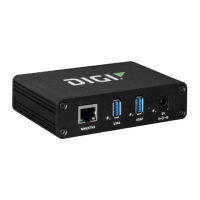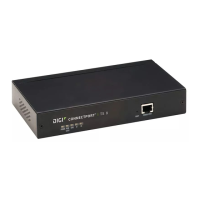Virtual Private Networks (VPN) IPsec
AnywhereUSB® Plus User Guide
576
b. Set the hostname selection type:
(config vpn ipsec tunnel ipsec_example)> remote hostname_selection
value
(config vpn ipsec tunnel ipsec_example)>
where value is one of:
n
round_robin: Attempts to connect to hostnames sequentially based on the list
order.
n
random: Randomly selects an IPsec peer to connect to from the hostname list.
n
priority: Selects the first hostname in the list that is resolvable.
c. Set the ID type:
(config vpn ipsec tunnel ipsec_example)> remote id type value
(config vpn ipsec tunnel ipsec_example)>
where value is one of:
n
auto: The ID will be automatically determined from the value of the tunnels
endpoints.
n
raw: Enter an IDand have it passed unmodified to the underlying IPsec stack.
Set the unmodified ID that will be passed:
(config vpn ipsec tunnel ipsec_example)> remote id type raw_id
id
(config vpn ipsec tunnel ipsec_example)>
n
any: Any ID will be accepted.
n
ipv4: The ID will be interpreted as an IPv4 address and sent as an ID_IPV4_ADDR
IKE identity.
Set an IPv4 formatted ID. This can be a fully-qualified domain name or an IPv4
address.
(config vpn ipsec tunnel ipsec_example)> remote id type ipv4_id
id
(config vpn ipsec tunnel ipsec_example)>
n
ipv6: The ID will be interpreted as an IPv6 address and sent as an ID_IPV6_ADDR
IKE identity.
Set an IPv6 formatted ID. This can be a fully-qualified domain name or an IPv6
address.
(config vpn ipsec tunnel ipsec_example)> remote id type ipv6_id
id
(config vpn ipsec tunnel ipsec_example)>

